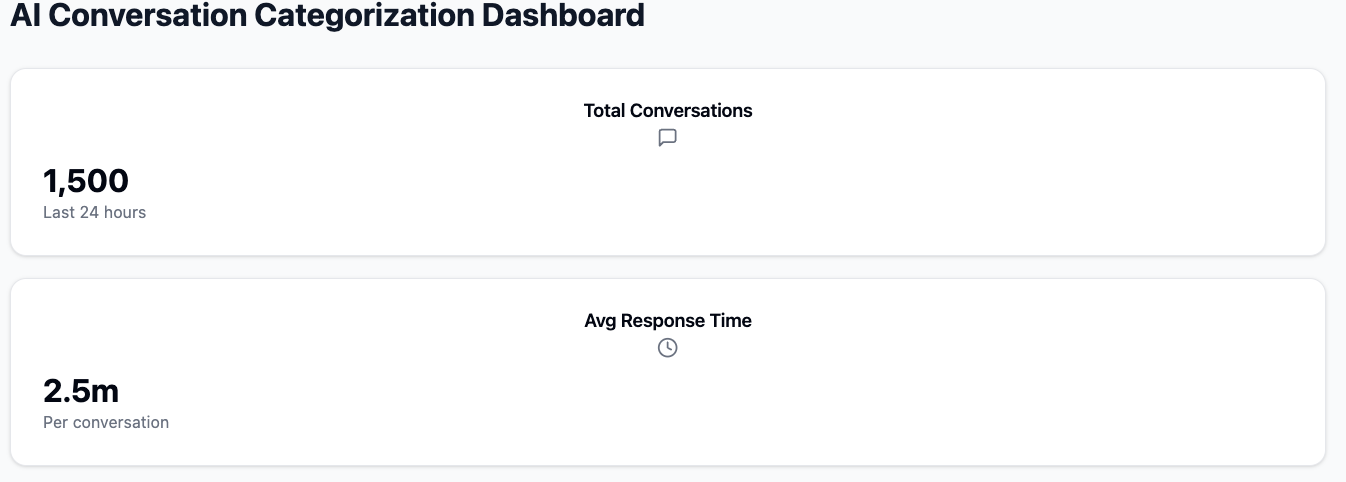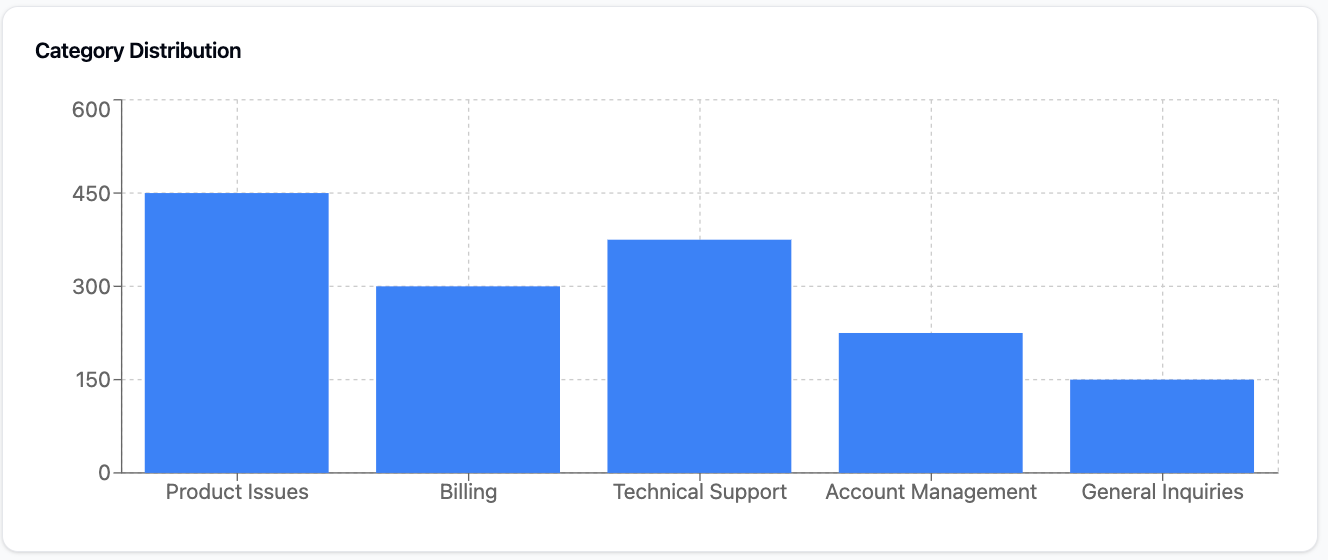AI Conversation Categorization: Organize Customer Interactions Effortlessly
AI Conversation Categorization: Organize Customer Interactions Effortlessly
Today businesses are handling thousands of customer interactions daily across multiple channels. Making sense of these conversations and organizing them has become a big challenge. AI is changing how organizations categorize and use these conversations, turning what was once an overwhelming task into a competitive advantage that can significantly boost customer satisfaction.
The Evolution of Customer Interaction Management
Traditional way of organizing customer interactions was manual tagging, filing and categorization—a time consuming process prone to inconsistencies and human error. AI has changed the landscape by introducing intelligent systems that automatically categorize and organize conversations with remarkable accuracy and speed, leading to effective customer interaction management.

Understanding AI-Driven Customer Experience
What is AI-driven customer experience?
AI-driven customer experience refers to the use of artificial intelligence (AI) technologies to enhance and personalize customer interactions across various touchpoints. This approach enables businesses to deliver tailored experiences that meet individual customer needs, preferences, and expectations. By leveraging machine learning algorithms, natural language processing (NLP), and data analytics, businesses can analyze customer data, behavior, and feedback to create a more human-like and empathetic experience. This not only boosts customer satisfaction but also fosters loyalty and retention, as customers feel understood and valued.
The rise of AI in personalization of Customer Experience
The rise of AI in personalization of customer experience has revolutionized the way businesses interact with their customers. AI-powered chatbots, virtual assistants, and recommendation engines have become indispensable tools, allowing businesses to deliver personalized experiences at scale. According to a recent report, the global AI personalization market is projected to grow at a compound annual growth rate (CAGR) of 24.17% from 2023 to 2032, reaching a market size of USD 371.1 million by 2032. This surge is driven by the increasing demand for personalized experiences, the need for businesses to stand out in a competitive market, and the rapid advancements in AI technologies.

Benefits of AI-driven customer experience for customer satisfaction
AI-driven customer experience offers numerous benefits that significantly enhance customer satisfaction:
-
Personalization: AI-powered systems analyze customer data and behavior to deliver tailored experiences that meet individual needs and preferences, making customers feel valued and understood.
-
Improved response times: AI-powered chatbots and virtual assistants can respond to customer inquiries in real-time, reducing wait times and enhancing overall customer satisfaction.
-
Enhanced customer insights: AI-powered analytics provide businesses with valuable insights into customer behavior, preferences, and expectations, enabling data-driven decision-making.
-
Increased operational efficiency: AI systems automate routine tasks, freeing up customer service agents to focus on more complex and high-value interactions, thereby improving operational efficiency.
-
Improved customer engagement: AI-powered systems engage customers in a more human-like and empathetic manner, fostering stronger customer relationships and increasing loyalty and retention.
Game-Changing Benefits
Effortless Organization
AI brings unprecedented efficiency to conversation management by:
-
Automatically categorizing interactions by theme
-
Identifying customer intent and sentiment
-
Creating systematic organization structure
-
Consistency across all channels

Better Customer Experience
Smart categorization means better customer service by:
-
Quick access to conversation history
-
Personalized responses based on previous interactions
-
Personalized customer experiences through intelligent call routing and Preview Dialer capabilities, enabling agents to prepare for customer interactions by accessing relevant information
-
Consistent handling of similar questions
-
Proactive issue resolution
Productivity Boost
Support teams benefit from organized conversations by:
-
Quickly identifying high priority issues
-
Access to historical data instantly
-
Focusing on complex problems
-
Reducing time spent on administrative tasks
Real-World Applications
Smart Ticketing
AI changes ticket handling by:
-
Automatically categorizing incoming tickets
-
Routing issues to the right teams
-
Prioritizing urgent matters
-
Tracking progress
Sentiment Based Prioritization with Natural Language Processing
AI analyzes customer emotions to:
-
Identify unhappy customers
-
Prioritize negative interactions
-
Track sentiment trends to gain deeper insights into customer behavior and feedback
-
Enable proactive intervention
E-commerce Support Excellence
E-commerce sites use AI categorization to:
-
Organize product related queries
-
Manage shipping and returns
-
Track customer satisfaction
-
Reduce response times
Sales Process Optimization
Sales teams use categorized conversations to:
-
Track leads through the sales funnel
-
Identify promising opportunities
-
Personalize follow up communications
-
Measure conversion rates
Training AI Models for Customer Interactions
Prepare the Data for AI Model Training
Preparing the data for AI model training is a critical step in developing effective AI-powered customer interaction systems. Here are the essential steps to ensure your data is ready for AI model training:
-
Collect and integrate data: Gather data from various sources, including customer interactions, feedback, and behavior. Integrate this data into a unified platform to create a comprehensive view of the customer journey.
-
Clean and preprocess data: Clean and preprocess the data to remove errors, inconsistencies, and irrelevant information. High-quality data is crucial for training an accurate and effective AI model.
-
Label and categorize data: Label and categorize the data to help the AI model understand the context and intent behind customer interactions. This step is vital for accurate categorization and response generation.
-
Split data into training and testing sets: Divide the data into training and testing sets to evaluate the AI model’s performance and make necessary improvements. This ensures the model’s reliability and effectiveness.
-
Continuously update and refine data: Regularly update and refine the data to maintain the AI model’s accuracy and effectiveness over time. Continuous learning and adaptation are key to meeting evolving customer expectations.
By following these steps, businesses can develop robust AI models that enhance customer interaction management, leading to improved customer satisfaction and operational efficiency.
Implementation Strategies
To implement AI conversation categorization:
- Assess Current Situation
-
Evaluate current categorization system
-
Identify pain points in current process
-
Define categorization objectives
-
Map conversation flows
- Choose the Right Tool
-
Select AI tools that integrates with your existing system
-
Scalability for future growth
-
Customization needs
-
Multi-channel support
- Get Your Team Ready
-
Train on new tools
-
Categorization guidelines
-
Roles and responsibilities
-
Support processes
- Monitor and Refine
-
Categorization accuracy
-
User feedback
-
System performance
-
Categories and rules
-
Customer feedback
Data-Driven Insights
AI categorization gives you:
-
Common customer issues
-
Interaction patterns
-
Response effectiveness
-
Future trends
Knowledge Base
Smart categorization enables self-service by:
-
Frequently asked questions
-
Topic organization
-
Auto-update documentation
-
Suggest new content
Compliance and Quality Assurance
AI ensures standards by:
-
Regulatory compliance monitoring
-
Quality check automation
-
Conversation audit trail
-
Policy adherence tracking
What’s Next
As AI evolves we’ll see:
-
More complex categorization algorithms
-
Better understanding of context and nuance
-
Multi-language support
-
Deeper business system integration
Cross-Channel
Modern AI systems can unify conversations across:
-
Email
-
Chat
-
Social media
-
Phone
-
Video
Conclusion
AI conversation categorization is a fundamental shift in how organizations manage customer interactions. By providing effortless organization, better customer experience and data insights, these systems turn customer communication from a challenge into a competitive advantage.
The key is to view AI categorization not as a filing system but as a service delivery tool that deepens customer understanding. Organizations that adopt these technologies while keeping customer service at the core will be well placed to deliver great experiences in a complex communication world.
For businesses looking to compete in a customer centric world, AI conversation categorization isn’t an option—it’s a necessity. The future of customer interaction management is here and it’s more organized, more insightful, more effective than ever.
